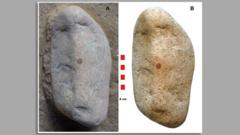Scientists in Spain are buzzing with excitement over a recent archaeological discovery that could change perceptions of our ancient relatives, the Neanderthals. Upon excavating a rock resembling a human face in the San Lázaro rock shelter in Segovia, researchers unveiled what is believed to be the oldest full human fingerprint, marking a pivotal moment in the history of Neanderthal artistry.
Dating back around 43,000 years, the discovery involves a Neanderthal man who is thought to have dipped his finger into red pigment to create a nose on the rock. Found beneath 1.5 meters of sediment indicative of Neanderthal habitation, this pebble’s strategic markings suggest that Neanderthals had the cognitive ability for symbolic behavior, thereby contributing to the ongoing discourse regarding their artistic capabilities.
Co-author María de Andrés-Herrero, a professor from the University of Complutense in Madrid, shared insights into their excavation process during an interview. She noted the surprising initial reaction upon uncovering the stone—situated amidst smaller rocks, the presence of its reddish dot stood out dramatically, evoking the semblance of a human face.
The verification of the red dot as pigment has led to collaborative efforts with Spain's scientific police, employing advanced multi-spectrum analyses to confirm the fingerprint’s origins. While there is uncertainty in drawing conclusive parallels given no prior Neanderthal references exist, archaeologist David Álvarez Alonso remarks on the uniqueness of the find as the oldest known painted portable art in Europe created by Neanderthals.
Official Gonzalo Santonja, in a recent briefing, emphasized the significance of the pebble, asserting it as a previously unseen artifact in the realm of Neanderthal artistry. The lack of functional context surrounding the fingerprint suggests intentional artistic motives, as Prof. Herrero postulates that the stone's unique fissures prompted an intentional mark from a Neanderthal using ochre pigment.
Importantly, researchers deduce the ochre pigment did not naturally occur within the shelter, indicating that it had been deliberately transported there, thereby enhancing claims of an artistic intention behind the markings. The findings have been documented in the journal Archaeological and Anthropological Sciences, which portrays the pebble's characteristics as worthy of consideration as a work of art within certain contexts, marking a revolutionary stance on Neanderthal's symbolic capabilities.





















